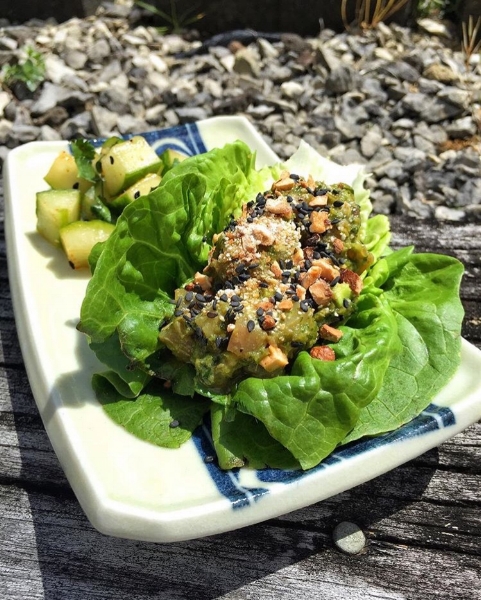Whenever I crave comfort food, my mind often wanders towards carbohydrate-rich dishes such as pasta, bread or risotto immediately. It's also quickly followed by extreme lethargy once I've overdosed on said carbs because I can never seem to stop myself from having that last mouthful of carb that tips me over the edge despite being full. Over the years, I've found other healthier substitutes so that I may have my proverbial cake and eat it (and bit more will power!).
Barley is one of those healthier substitutes which can be used in so many different ways – in salad, soups, stews or risotto, to name a few. An ancient grain that is high dietary fibres, magnesium and selenium, I often use barley as a lighter way to enjoy risotto. The simple recipe below is for a miso mushroom risotto topped with “pangrattato” (a flavoursome Italian breadcrumb topping) to add a little texture to the palate. For me, miso and mushrooms are a match made in heaven so it made sense to pair them up to create this twist on the traditional Italian version.
Serves 4 (medium sized servings)
Risotto
2 tbsp olive oil
1/2 a white onion, finely diced
4 cloves of garlic, crushed
250gm mixed mushrooms, cut into bite sized chunks
150gm cups of pearl barley
1L brown miso soup (you may also use white miso if you can't find brown miso)
4-5 tablespoons extra miso paste (as extra flavouring. Do not mix this into the miso soup)
Salt and pepper to taste
1 heaped teaspoon of umami paste (substitute with 2-3 anchovy fillets if you're unable to find umami paste, or replace with additional miso paste for a vegetarian option)
Zest of 1 lemon
Large handful of garlic chives, finely chopped
To Serve
Sautéed mushrooms
1 tbsp olive oil
3 cloves of garlic, crush
250 grams mixed mushrooms, sliced
Salt and pepper to taste
Pangrattato
80ml olive oil
3 cloves of garlic, chopped finely
1 tspn dried chilli flakes (optional)
1 cup of breadcrumbs
Zest of 1 lemon
Large bunch of wild garlic leaves, finely chopped (replace with Italian / flat leaf parsley if wild garlic leaves aren't available)
Method
1. Heat the olive oil in a large heavy based pan and gently fry the onion and garlic on a low-medium heat until they're translucent (don't be tempted to turn up the heat as the garlic and onion will burn easily and leave your risotto with an acrid taste). Season with a pinch of salt and pepper, and transfer to a bowl
2. Return the pan to the hob and turn up the heat. Add another tablespoon of olive oil to the pan and sauté the mushrooms until they're brown (ensure that the pan isn't over-crowded with mushrooms as this will steam the mushrooms. Split the mushrooms into two portions if your pan isn't large enough. Only add salt at the end of the sauté process as adding salt too early will release any residual moisture from the mushrooms, causing them to steam instead of sauté)
3. Add the cooked onion and garlic back in to the pan, once the mushrooms have been sautéed
4. Add the pearl barley and give the contents a good mix to coat the barley well with all the lovely goodness
5. Add 750ml of miso soup, and bring to the boil before reducing the heat to a gentle simmer
6. Let the barley simmer for 40-50 minutes, stirring occasionally to help release gluten from the barley. This will give the barley the same consistency as a risotto (more miso soup might be required if the liquid evaporates quickly. Add the remaining 250ml of miso soup a little at a time until the barley is cooked. The consistency of the barley shouldn't be dry and should be similar to a creamy risotto)
7. While the barley is cooking, prepare the remaining mushrooms and pangrattato, separately
8. Heat 1 tablespoon of olive oil to medium-hot in a pan large enough to hold mushrooms. Add the garlic to the oil and gently cook until it starts to become fragrant. Add the sliced mushrooms and sauté until they're brown. Add salt and pepper to taste, and set the mushrooms aside until you're ready to serve
9. Return the pan back to the hob and heat 80ml of olive oil to medium-hot, but not smoking. Add breadcrumbs, chilli flakes (if using) and a sprinkle of sea salt and sauté for about 5 minutes, or until breadcrumbs are golden
10. Add the finely chopped garlic and cook for another minute
11. Toss in the chopped wild garlic (or parsley) and remove from the heat, then stir through the lemon zest
12. Season with pepper and a little more sea salt to taste, then remove from the pan and set aside in a bowl until you're ready to serve
13. Once the barley risotto is cooked, stir in the finely chopped garlic chives and zest of 1 lemon. Adjust the seasoning of the risotto with salt, pepper and the additional miso paste if required. Everyone's palate will be different so adjust to suit yours
14. Spoon the barley risotto in to bowls and top with the remaining sautéed mushrooms and pangrattato, and serve immediately.






